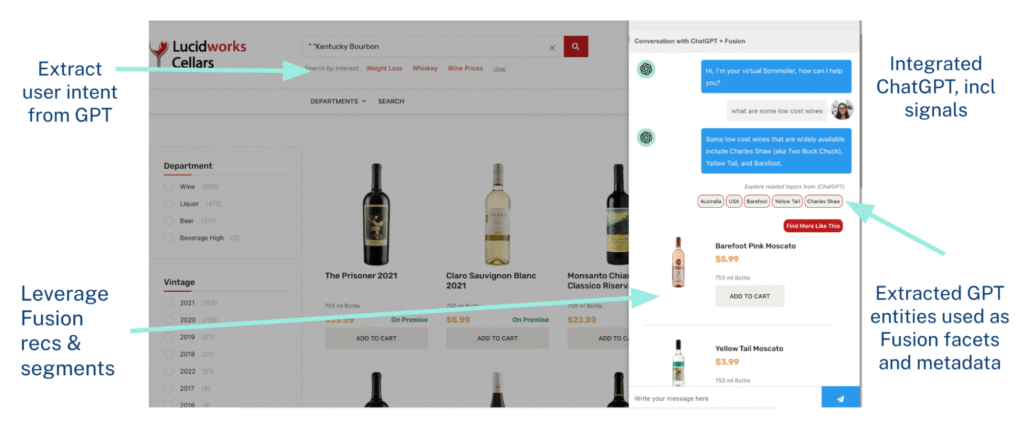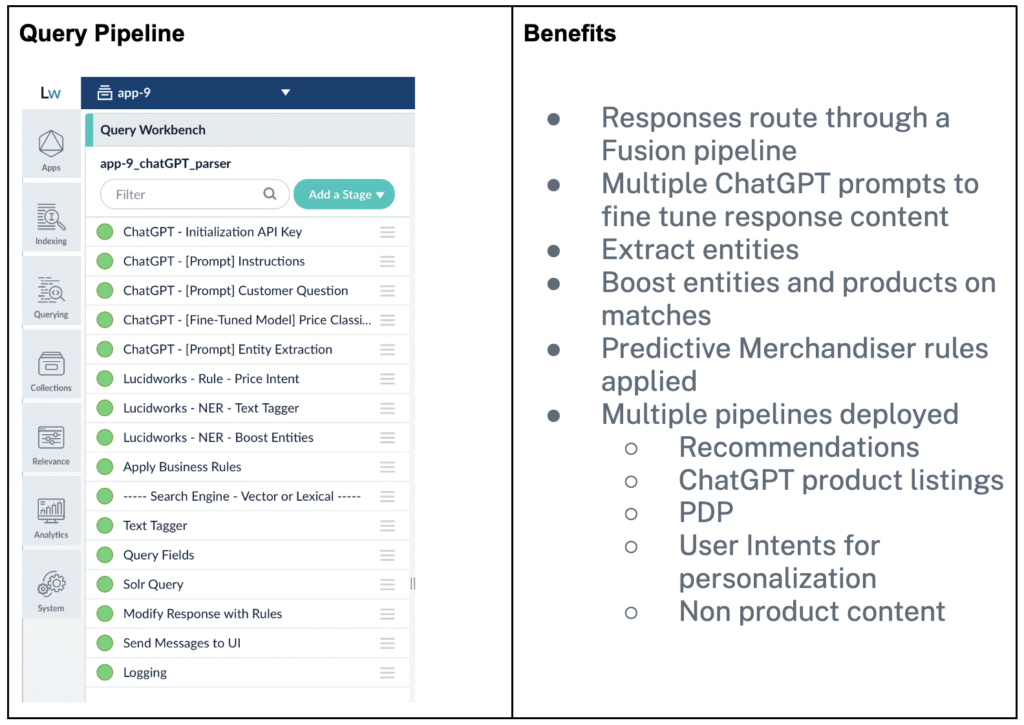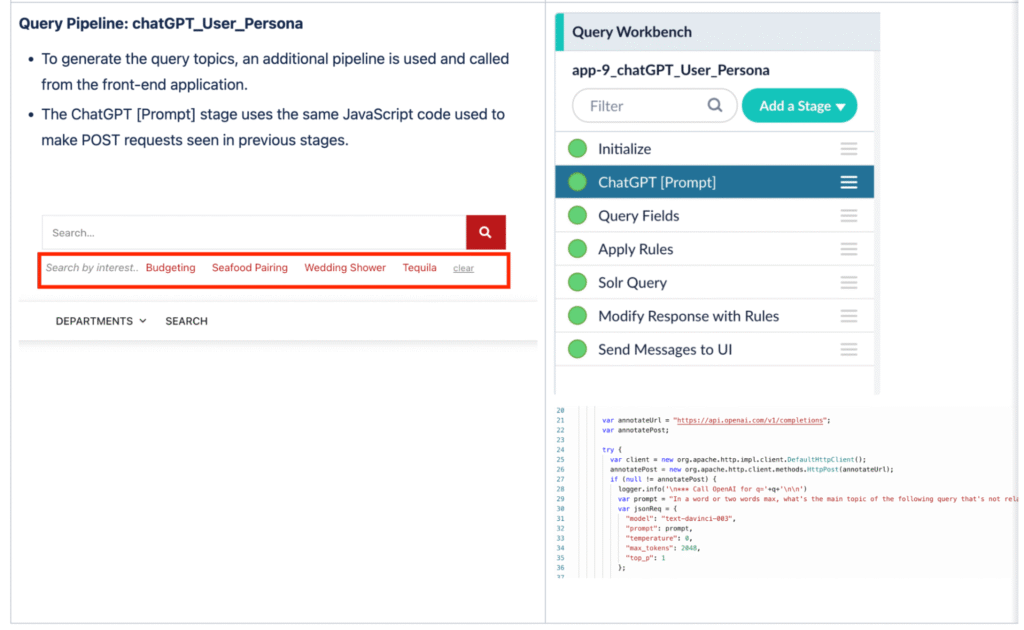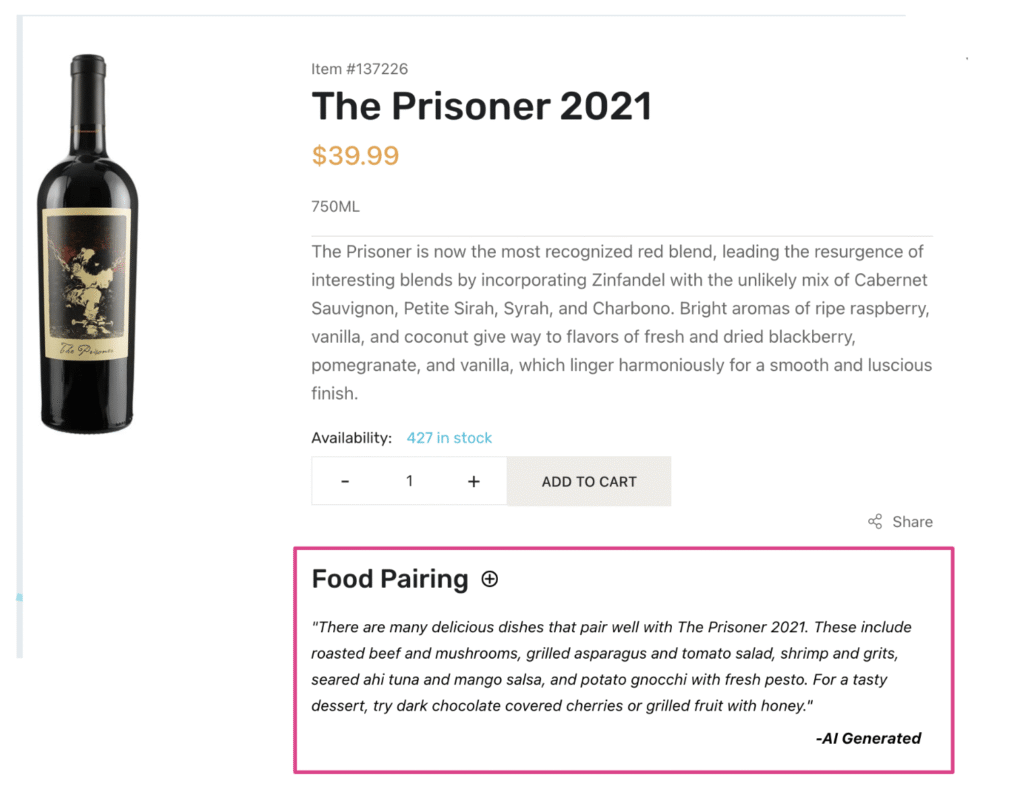
Why Lucidworks and ChatGPT?
Six months ago, one of our major customers challenged us to integrate OpenAI and our search platform for an employee experience use case. They viewed both of us as their strategic vendors and wanted to see how much value they can extract by leveraging large language models, but still maintain the controls and user experience Lucidworks provides for their employees.
Since then, we’ve seen very strong interest for an integrated ChatGPT and Lucidworks Platform experience across multiple use cases (Commerce, Knowledge Management, Customer Service, etc). There is a lot of hype around ChatGPT as of late. While some customers ask why they need a search platform in addition to ChatGPT, it’s important to underscore that a robust search platform is still required to get the full value out of large language models such as ChatGPT.
Some benefits of an integrated ChatGPT and Lucidworks solution:
- Guardrails and control – limit ChatGPT responses to your catalog and document
- Data enrichment – extract metadata and send back to Lucidworks for future use
- Security – filter out products and documents by userid or segment
- Seamless, integrated experience between ChatGPT and Lucidworks, including facets
- Non-product content – ask ChatGPT about complementary content
- Commerce Studio – merchandiser control of product display
- Personalization and Recs – leverage Recs in Lucidworks to display in ChatGPT
- Connectors – connect any data and use as training data for ChatGPT
- Signals Beacon and training processes – system continually improves with your data and user behavior
- Performance – users tend to bounce quickly with slow response times, which is typical of a chat experience
Another limitation of ChatGPT is its lack of knowledge around domain-specific content. While it can generate coherent and contextually relevant responses based on the information it has been trained on, it is unable to access domain-specific data or provide personalized answers that depend on a user’s unique knowledge base. Users should, therefore, exercise caution when seeking advice or answers on such topics solely from ChatGPT.
The HOW
How do we do it? One key differentiator between Lucidworks and other search engines is that customers can bring in any machine learning model into the Lucidworks Platform, including large language models such as ChatGPT, Bard (Vertex PaLM API, Bloom, etc). Lucidworks’ flexible index and query pipelines allow the platform to transform a large language model response (including entity enrichment and others).
In the flow diagram below you will see how all queries are routed through Lucidworks query pipeline first, including the ChatGPT response. This allows Lucidworks to interpret the ChatGPT response and do a number of things before returning the message to the user. For example, extract entities, facets, recs, and filter out unwanted data.
The same can be done at index time, which is a big cost of ownership driver for enterprises. For example, instead of calling ChatGPT API at query time, you do this at index time to enrich the metadata for your catalog or document index. There are a lot of advantages in enriching your data using large language models at index time.

By controlling the ChatGPT response, you can see in this demo below a fully integrated, seamless experience with Lucidworks and ChatGPT. Lucidworks extracts the entities from the ChatGPT response and uses them for entity extraction, facets, and boosting. The product listing in the chatbot comes from another Lucidworks Query Pipeline, which can be powered by recommendations, personalization, or even boost/bury rules driven by Predictive Merchandiser (merchandiser tooling). Under the search bar, we extract “user intents” from various ChatGPT questions for further personalization.
Below is an example of a Lucidworks Query Pipeline. Pipelines execute from the top down. You’ll notice we use multiple ChatGPT Prompts to initialize and fine tune the responses that come back to Lucidworks. For example, you can use a Prompt to extract entities from the response (ie, Brand, Vintage, Region). Once we have that metadata from ChatGPT, we can map to things in Lucidworks like Facets or use for relevancy boosting. We can also use a prompt to get more information from the response, such as “In two words or less, tell me what this user is asking”. This is great for personalization use later down the product discovery journey.
Later Query Pipeline stages do things like understanding price intent, and apply business rules that may be defined in Predictive Merchandiser (merchandiser UI).

The additional power in this example is leveraging a Query Pipeline stage to get more context from a GPT LLM. Here is an example of a Prompt ChatGTP stage. The Prompt to ChatGPT is simply “In a word or two, what’s the main topic of the following query”. The responses are then used to power the “Search by Interest” links under the search bar, which can be used for future personalization. These can be used in session and/or stored in a Lucidworks collection for future use. You can have multiple Prompts, including finely tuned classifier stages.

You can use ChatGPT Prompts for other things like non-product content as well. For example, on the PDP, write a Prompt “What food goes well with this wine?” This can also be controlled from Predictive Merchandiser.

In summary, the Lucidworks Platform grounds large language models in the truth. We have demos ready now for ChatGPT (OpenAI GPT4), Bard (Google Vertex PaLMAPI), and other large language models. Contact us for more information or a demo of your own data.